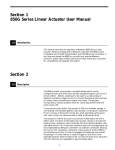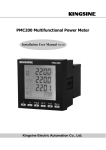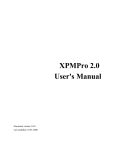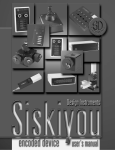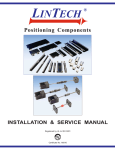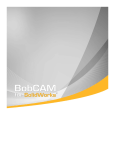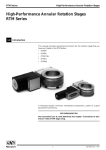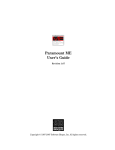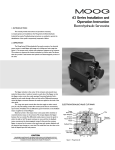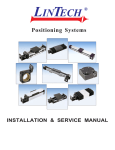Download 850F Series Linear Actuators User`s Manual
Transcript
850F Series Linear Actuators User’s Manual 1.0 Introduction This manual describes the operation of Newport 850F Series Linear Actuators. When purchased with a Newport controller, the 850F is fully compatible with the MotionMaster family of controllers and the PMC200 Series controllers. If you have purchased the 850F for use with your existing Newport controller, please read carefully the section below listing your controller for compatibility and upgrade information. 2.0 Description The 850F actuator incorporates a versatile design which can be configured with travel limits from as little as approximately 1/32 inch to 2 inches (0.8mm - 50mm), enabling it to be used on a wide variety of Newport translation stages and mirror mounts. Mechanical limit switches cut motor power preventing accidental over-travel. The actuator incorporates a manual actuation knob for coarse adjustment (with the motor power off). To provide accurate motion, the actuator’s 3/16 inch diameter plunger is non-rotating. The standard gearbox ratio actuator can produce a maximum thrust in excess of 25 pounds (11 kg); but, when operating continuously over many cycles, the maximum load is rated at 18 pounds (8kg). The actuator’s internal structure is a precision-rolled leadscrew with a pitch of 32.3885 threads per inch. The pitch of the leadscrew has been chosen to provide exactly .05µm encoder resolution when combined with the standard gearbox ratio (see table section 3.4). Production variations about this average figure can be compensated by Newport controllers via software commands allowing the user to limit cumulative, monotonic inaccuracies to within 0.005%. A non-rotating low friction Turcite nut engages the leadscrew and pushes the plunger. A brass half-nut is used to trigger a travel limit in the extended position while the lead screw nut trips the limit at full retraction. The limit switches are repeatable to approximately 40µm. CAUTION If the actuator encounters a hard stop within its range of travel (a translation stage’s or mirror mount’s end of travel for example), a slip clutch releases to prevent damage to the gearhead. The clutch is designed to slip just below the motor’s maximum torque. The motor should be stopped as soon as possible to prevent overheating in this high torque condition. 1 These actuators are powered by a low inertia DC motor to provide smooth movement with low acoustic and mechanical noise. Submicron resolution is obtained with a precision-rolled and electropolished stainless steel leadscrew driven through a low backlash reduction gear. The overall drive train backlash of ~15µm can be compensated by Newport controllers. Bidirectional repeatability to 1.0 µm can be achieved through this feature. The motor has an ironless-rotor to permit fast response due to its low inertia. The brushes are precious-metal plated for long life. The factory lubrication has a vapor pressure of 10-6 Torr at 25°C. 2.1 Controller Interfaces The 850F Series actuators incorporate many new features, such as travel limit switches and manual actuation, not found in previous Newport actuators like the 850, 850A, and 850B Series. Additionally, since the 850F uses a higher torque motor, the servo parameters required for smooth operation are different than for previous actuators. For these reasons, controllers sold before the introduction of the 850F may not be compatible and will require a special interface adapter. Some controllers have been phased out and are not supported for the 850F. 2.1.1 MM1000DC/DCS750 The MM1000DC Controller/Driver (formerly DCS750) has been phased out and is not supported to drive 850F Series actuators. 2.1.2 MM2000 PC Card Motion Controller The MM2000 controller drives up to four 850F actuators via Newport’s Universal Interface Box (UIB) P/N 21463-01 and using firmware version 1.4 or later. The controller firmware version may be displayed by using the VE command. (Note that since the actuators are using the computer’s internal power supply, there is a limitation of 2 axes which may move simultaneously. Future versions of the UIB will incorporate an external power supply for applications requiring 3 or more axes of simultaneous movement.) The UIB provides relays to cut motor power for manual knob use and firmware version 1.4 or later provides commands to properly enable manual positioning and keep track of encoder counts during a manual move. The UIB may be purchased as an option when ordering an MM2000 controller and the proper version of the firmware is assured. To upgrade an existing MM2000 controller with firmware version 1.4 or earlier, the UIB must be purchased separately. The existing firmware may be used with the following work around for manual actuation. When sending the MOTOR OFF (MF) command, the I/O bits on the UIB which control the power relays must be toggled manually using the DEFINE BITS (BO), CLEAR BITS (CB), and SET BITS (SB) commands. Refer to the MM2000 user manual and the data sheet included with the UIB for more details. Caution Failure to manually toggle the I/O bits on the UIB for controllers with firmware version 1.4 or earlier will leave power applied to the motor after the MOTOR OFF command has been issued. Do 2 not try to manually adjust actuator position with power applied to the motor or damage will result to the gearhead. Manual positioning should not require more torque to turn the knob with the actuator cable attached than with it unplugged. If you’re unsure about the effort required, unplug the actuator to compare the feel of the knob before proceeding. 2.1.3 MM2000RX Rack Mounted PC Card Controller Existing MM2000RX controllers are incompatible with the 850F. Factory upgrades may be done on a special request basis. New MM2000RX controllers may be purchased to be compatible with the 850F on a special request basis. Please call Newport for the latest information. 2.1.4 MM3000 Motion Controller/Driver The MM3000 is completely compatible with the 850F Series actuators. All that is required is to configure the controller with the proper driver card and adjust the servo parameters per the specifications included in the controller documentation. 2.1.5 MM4000 Motion Controller/Driver The MM4000 is completely compatible with the 850F series actuators. All that is required is to configure the controller with the proper driver card and adjust the servo parameters per the specifications included in the controller documentation. 2.1.6 PMC100 Single Axis Controller Existing PMC100 controllers are incompatible with 850F actuators. Please call Newport for the latest information regarding upgrades for the PMC100. 2.1.7 PMC200/PMC200-P Dual Axis Controller PMC200 Series Controllers using version 3.1 or earlier firmware are incompatible with 850F Series actuators and require an upgrade. The firmware version is displayed on power up. Please call Newport for the latest information regarding upgrades. PMC200 Series Controllers using version 4.0 or later are compatible with the 850F Series actuators and include the proper interface to handle the limit switches and manual knob. Servo parameters may be set by selecting type 850F in the controller setup menu. There is also a menu to toggle motor power off for manual positioning. An adapter cable (P/N 21731-01) must be ordered for each 850F actuator. 3 Caution Failure to toggle motor power off before attempting to manually position the 850F will result in damage to the motor gearhead. Manually positioning should not require more torque to turn the knob with the actuator attached than with it unplugged. If you are unsure about the effort required, unplug the actuator to compare the feel of the knob before proceeding. 2.1.8 PMC400 Multi-Axis Controller/Driver The PMC400 Controller/Driver has been phased out and is not supported to drive 850F Series actuators. 2.1.9 Non-Newport Controllers If you are using a non-Newport controller/driver please refer to the connector pinout provided. Note that in order to utilize the manual knob feature, power must be removed from the motor (open circuit). Failure to do so properly may result in dynamic braking on the motor and cause damage to the gearhead, invalidating your warranty. 3.0 Installation, Set-up, and Operation The actuators are shipped in sturdy, foam-cushioned boxes. Please inspect the actuators and/or controllers immediately and notify the carrier if damage is obvious. The actuator includes extra flat head case screws, a wrench to access the travel limit adjustment and a retaining nut for actuator mounting. 3.1 Setting the Travel Limits Before mounting the 850F actuator, follow the directions below to adjust the travel limits such that the actuator will trigger one of its limit switches before encountering any external hard stop such as the end of travel of a translation stage. Failure to do this may result in damage to the actuator and/or the stage. Actuators are shipped with the travel limit set to less than 1/2 inch (12mm) to prevent accidental over-travel in most instances. 3.1.1 Remove the Coarse Travel Indicator Window Find a clean flat surface to disassemble the actuator. (Tapped hole optical tables are not recommended since many of the parts are small and may drop into the table). Using the manual knob, adjust the actuator to the 4 zero position as read on the coarse position scale as shown in Figure 1. Remove the four #2-56 flat head screws holding the indicator window lid, place them to the side and gently pry off the lid. (Figure 2) Figure 1 - Remove the indicator window lid with the actuator in the zero position. Figure 2 - Approximate travel range markings assist in quick travel adjustment. 3.1.2 Reposition the Half-Nut to the Desired Travel After removing the lid, laser marked lines indicating approximate travel ranges can be seen. Remove the half nut by lifting it from the lead screw. Note its orientation with respect to the lead screw since it only fits one way. (Figure 3) Approximate travel is set by replacing the half nut onto the lead screw with its center scribe mark aligned to one of the markings on the actuator body. (Figure 4) These marks are only an aid to determining travel. The half nut may be placed anywhere along the lead screw. For full 2 inch (50mm) travel, remove the half nut completely and store it in a safe place for future use in case shorter travel is desired. Figure 3 - The half nut’s ramped corner triggers the positive limit switch. Figure 4 - Place the half nut on the leadscrew to set the approximate travel. 5 3.1.3 Replace the Coarse Travel Indicator Window After inspecting the half-nut placement to ensure that it is fully seated on the lead screw, replace the lid and tighten the four #2-56 screws. Be sure to tighten the screws completely for proper operation (Figures 5 & 6). If the lid is loose, the half nut may ride up off of the lead screw at the end of travel and defeat the purpose of the limit switch resulting possibly in damage to the actuator or the equipment it is moving. Figure 6 - Tighten all four screws securely for proper operation. Figure 5 - Replace the actuator lid, after seating the half nut on the lead screw. 3.2 Actuator Mounting The actuator may be mounted using either the 3/8 inch brass mounting sleeve or by attachment using the clearance holes in the actuator body. When using the brass mounting sleeve, the actuator may be mounted to a wide variety of Newport components in one of four ways: 1. Unscrew the retaining nut and insert the 850F into the mount. Either use a spanner wrench to tighten the nut, or if space permits, gently rotate the actuator body while holding the nut stationary with the fingers or a small screwdriver to tighten the whole assembly. 2. When the mount has a set screw, the retaining nut is not used. Just insert the actuator and tighten the set screw. 3. In rare cases, when neither of the above two mounting methods can be used, it might be necessary to partially disassemble the device the actuator is being used in. When access to the retaining nut side is reached, simply follow method #1 above. 4. For panel mounting in panels up to 1/2” thick, drill a 3/8” hole. Insert actuator and tighten retaining nut. 6 3.3 Manual Operation The 850F is equipped with a knob for manual coarse positioning (except low speed versions, 850F-LS). Approximate position in both inches and millimeters can be read using the scales on the window and the scribe mark on the lead screw nut. A small amount of resistance should be felt when turning the knob. This is a result of back driving the gearhead motor assembly and is normal. Attempt to turn the knob smoothly, avoiding abrupt starts and stops, to minimize the chance of damaging the motor gearhead. Power to the motor must be off while executing a manual move or damage may result to the gearhead. If excessive resistance is felt while trying to turn the manual knob, then check to verify motor power is off. If you are still unsure, disconnect the actuator cable completely and compare the turning resistance. It should be approximately the same as when the cable is attached with the motor power off. Caution As long as the cable remains attached, the encoder count is preserved and when power is reapplied to the motor, the new encoder count is updated to be the current position in the controller. Incompatible and non-Newport controllers which do not properly implement this feature may cause the actuator to jump to a previous position upon power on and this may result in damage to the attached equipment if a crash occurs. 3.4 High- and Low-Speed Versions 850F actuators are also available with two alternate speed ranges. This is accomplished through use of different gearbox ratios and motors with different torque characteristics as listed below. Model Standard Speed 850F, 850F-VC High Speed 850F-HS Low Speed 850F-LS Gearbox Motor Relative Speed Encoder Resolution 261.409912:1 1624 1x .05µm 22.0335039:1 1624 ~12x .59321µm 1669.99476:1 1516 ~1⁄6x .00783µm PMC200 Series Controllers accommodate the differing gear ratios via the “special” actuator coupling ratio parameter. The procedure for setting this parameter is documented in your controller’s manual. The coupling ratio can be calculated by the following simple formula: Coupling Ratio = 20,000 * gear ratio /262 That is, a standard speed actuator has a coupling ratio of 20,000. Highspeed actuators have a coupling ratio of 1,685.8. Low-speed actuators have a coupling ratio of 127,768.4. The units of the coupling ratio parameter are encoder-quadratures-per-millimeter. For MotionMaster controllers, use the CO command to compensate for the differing gearhead ratios. 7 Caution Actuators with gearhead ratios greater than 485:1 are more susceptible to damage when crashed into a hard stop. For high gearhead ratios, the motor’s momentum appears to be extremely high when moving at full speed. The mechanical limit switches will prevent a crash due to over-travel, but will not prevent the actuator from hitting a hard stop within the travel range (the end of run on a translation stage or mirror mount for example). Be sure to adjust the travel limits (Section 3.1) such that the limit switches are activated before the actuator reaches the end of stage travel. A slip clutch has been implemented in the drive train to minimize the probability of damage if a hard stop is encountered, but special care should be taken to avoid crashing the actuator. 3.5 Vacuum Compatible Versions Standard speed 850F actuators can be ordered to operate cleanly within a vacuum environment. The following describes the alterations that make the standard actuators vacuum compatible. The high vacuum model of the 850F Series Linear Actuator, model 850F-VC incorporates the following features: 1. Six foot Teflon-coated cable from actuator attached to six foot standard cable. 2. Unanodized aluminum body without label. 3. No fastener sealing compound. 4. The window material is removed. 5. Special lubricant with vapor pressure of 10-6 Torr at 39°C. 6. Vented motor/gearhead/encoder cavities. 4.0 Maintenance and Service This section describes maintenance and adjustment procedures which may be performed by the user. Caution Do not attempt to adjust the actuator mechanical assembly in any way other than outlined above (See Setting the Travel Limits). Any attempt to disassemble the actuator will cause a misalignment. Call the factory before you try to adjust, repair, or alter any of the 850F Series actuators without factory-provided instructions. Any unauthorized attempts to adjust, repair, or alter the actuators or controllers will invalidate your warranty. No scheduled maintenance is required for this product. The actuator should be cared for and handled as any fine instrument. Keep the unit clean and free of moisture, solvents, or other foreign matter. Sometimes general wear and tear can cause the actuator’s performance to degrade, indicating a need for service. Very often such problems as the actuator moving on its own and the actuator lacking thrust can be corrected by adjusting your controller’s servo parameters. 8 Connector Pin Assignments WIRE COLOR 1 2 3 4 5 6 7 8 9 10 11 12 13 14 15 16 17 18 19 20 21 22 23 24 25 BLACK WHITE NC NC NC NC NC SHIELD GND NC ORANGE GRAY YELLOW GREEN RED BLUE NC NC NC MOTOR + MOTOR – SHIELD GROUND FORWARD LIMIT SWITCH REVERSE LIMIT SWITCH CHANNEL A CHANNEL B +5 - +12V DC (5ma @ 5V DC) GROUND Drawing CBORE CLR HOLE FOR 1/4-20 (M6) CAP SCREW 0.25 (6.4) 0.31(7.9) 0 MM IN 5 10 15 20 25 30 35 0 .25 .5 .75 1.0 40 50 1.38 (35.1) 1.00 (25.4) φ 0.75 (19.1) 1.25 φ 0.187 (4.8) 0.88 MIN (22.4) 2" TRAVEL (50) 2.0 2.09 (53.1) φ 0.59 (15) φ 0.375 (9.5) 0.52 (13.2) 45° 0.63 (16) 45 0.88 (22.4) 4.84 (122.9) 3.25 (82.6) 1.75 6.0 CONNECTION PIN NC NC NC NC 1.5 5.0 0.13 (3.3) 0.44 (11.2) 0.63 (16) 8-32 (M4) CLR HOLE 2 PLACES 3/8-40 THREAD 25 PIN D TYPE CONNECTOR WITH 12 FOOT CABLE 9 7.0 Service Form (Photocopy and return to Newport) Newport Corporation U.S.A. Office: 714/ 863-3144 FAX: 714/ 253-1800 Name RETURN AUTHORIZATION # Company (Please obtain prior to return of item) Address Country Date P.O. Number Phone Number Item(s) Being Returned: Model # Serial # Description: Reason for return of goods (please list any specific problems) Please complete the below, as appropriate. List all control settings and describe problem: (Attach additional sheets as necessary) Show a block diagram of your measurement system including all instruments connected (whether power is turned on or not). Describe signal source. If source is a laser, describe output mode, peak power, pulse width, repetition rate and energy density. Where is the measurement being performed? (factory, controlled laboratory, out-of-doors, etc.) What power line voltage is used? Frequency? Variation? Variation? Ambient Temperature? °F. Rel. Humidity? Other? Any additional information. (If special modifications have been made by the user, please describe below). 10 WORLDWIDE HEADQUARTERS NEWPORT CORPORATION 1791 Deere Avenue Irvine, CA 92606 (In U.S.): 800-222-6440 Tel: 714-863-3144 Fax: 714-253-1680 INTERNET [email protected] BELGIUM Tel: 016 402927 Fax: 016 40 2227 GERMANY Tel: 06151 3621 0 Fax: 06151 362150 ITALY Tel: 02 924 5518 Fax: 02 923 2448 NETHERLANDS Tel: 030 6592111 Fax: 030 6592120 SWITZERLAND Tel: 01 744-50-70 Fax: 01 744-50-77 CANADA In Canada: 800-267-8999 Tel: 905-567-0390 Fax: 905-567-0392 TAIWAN Tel: 2-506 2366 Fax: 2-507 9268 FRANCE Tel: 01 60916868 Fax: 01 60916869 UNITED KINGDOM Tel: 01635 521757 Fax: 01635 521348 I FI REG ST RM Visit Newport Online at: http://www.newport.com ERE D Certificate No.: FM 27207 Newport Corporation, Irvine, California, has been certified compliant with ISO 9002 by the British Standards Institution. IN-10955 (1-98) Printed in the USA on recycled paper 850F Series Linear Actuators User’s Manual Warranty Newport Corporation warrants this product to be free from defects in material and workmanship for a period of one year from the date of shipment. If found to be defective during the warranty period, the product will either be repaired or replaced at Newport’s option. To exercise this warranty, write or call your local Newport representative or contact Newport headquarters in Irvine, California, USA. You will be given prompt assistance and return instructions. Send the instrument, transportation prepaid, to the indicated service facility. Repairs will be made and the instrument returned, transportation prepaid. Repaired products are warranted for the balance of the original warranty period or 90 days, whichever is longer. This warranty does not apply to defects resulting from modification or misuse of any product or part. This warranty also does not apply to damage from use with a non-Newport motion controller/driver. This warranty is in lieu of all other warranties, expressed or implied, including any implied warranty of merchantability or fitness for a particular use. Newport Corporation shall not be liable for any indirect, special, or consequential damages. ©1995, Newport Corporation Irvine, California, U.S.A. IN-10955 (1-98) ii Table of Contents Page Warranty ..................................................................................................................ii Table of Contents ..................................................................................................iii Specifications .........................................................................................................iv Section 1 – Introduction ..............................................................................1 Section 2 – Description .................................................................................1 2.1 Controller Interface ...................................................................................2 2.1.1 MM1000DC/ DCS750 ..........................................................................2 2.1.2 MM2000 PC Card Motion Controller ...............................................2 2.1.3 MM2000RX Rack Mounted PC Card Controller .............................3 2.1.4 MM3000 Motion Controller/Driver ..................................................3 2.1.5 MM4000 Motion Controller/Driver ..................................................3 2.1.6 PMC100 Single Axis Controller ........................................................3 2.1.7 PMC200/PMC200-P Dual Axis Controller ........................................3 2.1.8 PMC400 Multi-Axis Controller/Driver .............................................4 2.1.9 Non-Newport Controllers .................................................................4 Section 3 – Installation, Set-up and Operation ................................4 3.1 Setting the Travel Limits...........................................................................4 3.2 Actuator Mounting ....................................................................................6 3.3 Manual Operation ......................................................................................7 3.4 High- and Low-Speed Versions.................................................................7 3.5 Vacuum Compatible Versions ..................................................................8 Section 4 – Maintenance and Service ..................................................8 4.1 Maintenance ...............................................................................................8 Section 5 – Connector Pin Assignments ...............................................9 Section 6 – Drawing .......................................................................................9 Section 7 – Service Form ...........................................................................10 iii Specifications Encoder Resolution Standard Actuators: High Speed Actuators: Low Speed Actuators: .05000 µm .59321 µm .00783 µm Part Number 850F, 850F-VC 850F-HS 850F-LS Nominal Gearbox Ratio and Maximum Speed Standard Actuators: 262:1 ratio (1624 motor); 400 µm/sec. High Speed Actuators: 22:1 ratio (1624 motor); 4750 µm/sec. Low Speed Actuators: 1670:1 ratio (1516 motor); 55 µm/sec. Backlash < 15 micron typical with external load of 2 lbs (1 kg) minimum Accuracy < 0.1% of travel, cumulative Bidirectional Repeatability Better than 1 micron when backlash is compensated by controller (standard actuators)* Encoder Magnetic, 2KHz; open collector, quadrature output, +5V to +12V supply Absolute cyclic pitch error < 1 micron Time to reach full speed < 50 msec at max. speed and acceleration settings Max. Side Load 5 lb. (2.3 kg) at full shaft extension Max. Axial Load 18 lb. (8 kg) standard and low speed actuators 5 lb. (2.3 kg) high speed actuators Cable 12 foot (3.6 m) cable integral to actuator terminated with 25-pin male Dsub connector Temperature Range 0°F to +120°F Actuator Case Black/clear anodized aluminum Vacuum Compatibility Special-order vacuum-compatible versions for operation to 10-6 Torr, temperature range restricted as stated above *Note: Backlash can be compensated by MotionMaster and PMC200 Series Controllers. Cumulative, monotonic error due to leadscrew pitch error or mounting errors can be compensated via the CO command in MotionMaster controllers and the coupling ratio parameter in PMC200 Series Controllers. iv

















